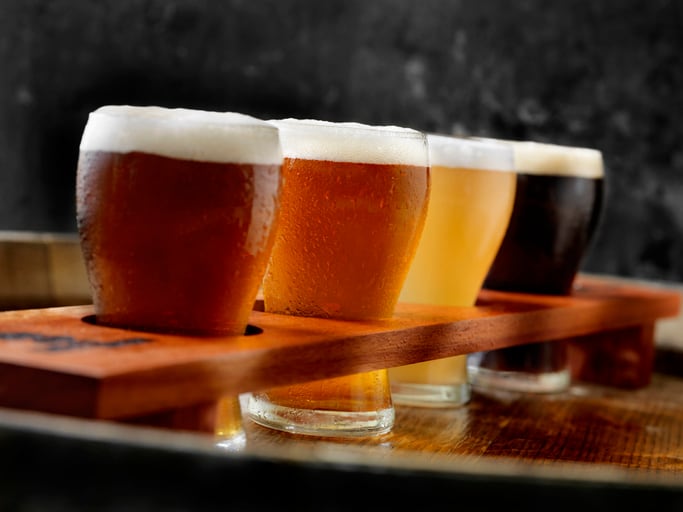The US craft beer industry once enjoyed meteoric growth rates. Today, it’s a maturing market that faces plenty of challenges.
But there’s plenty of room for optimism, says the Brewers Association, as it reveals the latest data.
Craft brewers produced 23.1 million barrels of beer in 2024, representing an unwelcome 3.9% decrease on 2023.
But craft beer’s retail dollar value rose to an estimated $28.9bn, a 3% increase over the previous year.
Crunching the figures
Craft beer has managed to outperform the overall US beer industry for many years. Last year, craft beer declined 1% by volume, relatively healthy compared to an overall decline of 5.1% in the US beer industry.
But in 2024, craft beer declined 3.9%, faster than the overall beer market at 1.2%.
That means craft’s market share dropped slightly to make up 13.3% of the total beer industry.
But craft beer has always been about value and a premium proposition, rather than value sales.
In 2024, craft beer value grew by 3% and accounted for 24.7% of the total beer market in retail dollar sales. This growth was, in part, driven by the success of onsite sales, which outpaced distributed sales in many markets.
But how does that compare to previous years? BeverageDaily crunches the numbers: while craft is not growing spectacularly, it is still holding its own.
| Number of craft breweries | Production growth (volume) | Craft beer market share | Overall beer market growth | ||
|---|---|---|---|---|---|
| 2019 | 8.419 | 4% | 13.6% | -2% | Maturing market |
| 2020 | 8,921 | -9% | 12.3% | -3% | Pandemic hit |
| 2021 | 9,210 | 8% | 13.1% | 1% | Pandemic rebound |
| 2022 | 9,675 | -2% | 13.2% | -3% | Normalization |
| 2023 | 9,761 | -1% | 13.6% | -5% | Craft beer declines less severe than overall beer |
| 2024 | 9,861 | -3.9% | 13.3% | -1.2% | Craft beer declines more pronounced than overall beer |
Taprooms and brewpubs
This drive towards taprooms, brewpubs and onsite sales has been a trend for several years post-pandemic: and it’s also evidenced in the brewery employment numbers.
Employment in the craft brewing sector increased to 197,112 in 2024, a 3.0% rise from the previous year.
In 2024, there were 9,861 operating U.S. craft breweries, including 2,034 microbreweries, 3,599 brewpubs, 3,948 taproom breweries, and 280 regional craft breweries.
2024 was the first year since 2005 that the number of breweries that closed outpaced brewery openings nationwide. However, this is not cause for alarm, says the Brewers Association. Over the year, 430 new breweries opened while 529 closed. That means a relatively low closure rate of around 5%.
What is a craft brewer?
The Brewers Association defines an American craft brewer as a small and independent brewer.
Small: That means an annual production of 6 million barrels of beer or less.
Independent: Less than 25% of the craft brewery is owned or controlled (or equivalent economic interest) by a beverage alcohol industry member that is not itself a craft brewer.
Brewer: Holds a Brewer’s Notice issued by the Alcohol & Tobacco Tax & Trade Bureau (TTB), or its successor, or control the intellectual property for one or more brands of beer, has that brand or brands brewed for it in the US, and have as its primary business purpose the resale of the brand or brands it controls.
So is the craft beer industry doing well or not?
Like the beer industry as a whole, craft beer faces many headwinds. And these are particularly felt by smaller brewers.
Craft brewers are already grappling with rising ingredient costs, and tariffs on imported brewing equipment (such as steel kegs, aluminum cans) and ingredients (such as hops and malt) only make these financial pressures worse.
Meanwhile, the craft beer industry faces competition in an increasingly saturated market from other products such as trendy RTD cocktails.
Or consumers are turning away from alcohol altogether.
As a result, many craft brewers are forced to delay expansion plans, raise prices or absorb losses.
But it also has to be remembered that craft beer is a mature market and not every year will deliver substantial growth. Savvy brewers are honing operations, adjusting business practices, and looking at where the opportunities are (alcohol-free beer, for example, is one area of innovation where craft brewers are already thriving).
And – perhaps most importantly – craft brewers can continue to hone their craft and set themselves apart from the crowd with quality.



